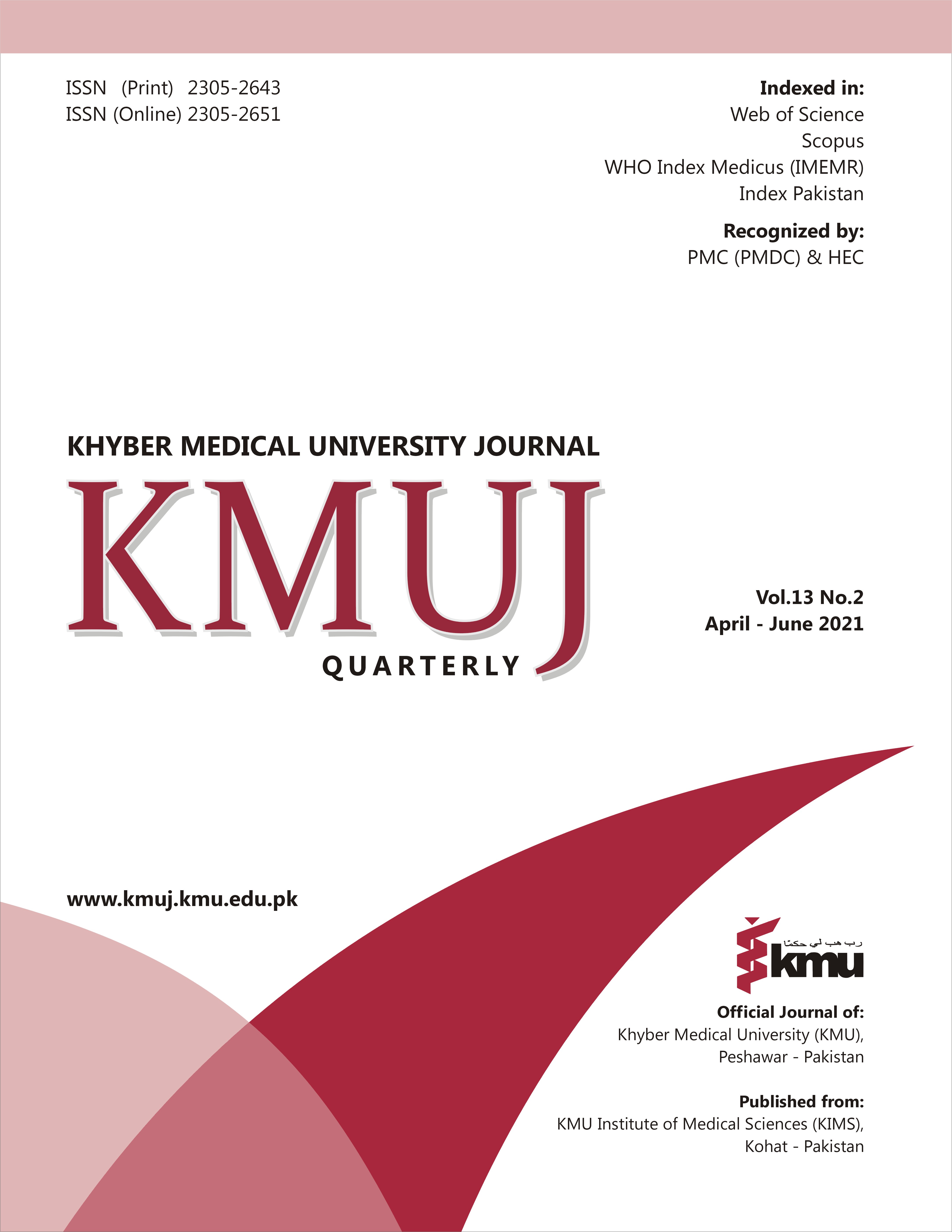ROLE OF MONTELUKAST IN PREVENTING RELAPSE IN CHILDHOOD IDIOPATHIC NEPHROTIC SYNDROME: A QUASI-EXPERIMENTAL STUDY
Main Article Content
Abstract
OBJECTIVE: To study the role of montelukast in preventing relapses in childhood idiopathic steroid sensitive nephrotic syndrome (SSNS).
METHODS: This quasi-experimental, open label study was conducted at Department of Paediatric Nephrology, The Children’s Hospital and The Institute of Child Health, Multan, Pakistan. Total of 106 patients with first-episode of nephrotic syndrome, aged 1-10 years were enrolled from February-May 2019 and non-randomly assigned to Group-A & Group-B (53 patients in each group). All patients in both groups were started on prednisolone 2mg/kg single morning dose for 4-weeks as per institutional protocol. Group-A (Cases) also received montelukast 5mg daily at bedtime for at least 12 months while Group-B (control) was not given montelukast. All patients were followed up for one year till May 2020 to monitor the response to treatment and evidence of relapse. Ten patients were excluded from final analysis due to loss to follow-up (n=3; 2 in Group-A and 1 in Group-B) or showing steroids resistance (n=7; 3 in Group-A and 4 in Group-B).
RESULTS: Out of 96 children (48 each in Group-A & B), 58 (60.4%) were males. Mean age was 4.7±1.9 years and most of children (n=64; 66.7%), were aged between 2-6 years. Overall relapse rate of 35.4% (n=34/98) was observed, with 9/48 (18.8%) patients in Group-A compared to 25/48 (52.1%) patients in Group-B (p<0.001). Out of 34 patients with relapse, 20 (58.8%) were males and 14 (41.2%) were females.
CONCLUSION: Montelukast showed significant efficacy in preventing relapse rate in children with SSNS during one year of follow-up.
Article Details
Work published in KMUJ is licensed under a
Creative Commons Attribution 4.0 License
Authors are permitted and encouraged to post their work online (e.g., in institutional repositories or on their website) prior to and during the submission process, as it can lead to productive exchanges, as well as earlier and greater citation of published work.
(e.g., in institutional repositories or on their website) prior to and during the submission process, as it can lead to productive exchanges, as well as earlier and greater citation of published work.
References
Eltigani A, Nahla E, Mohamed A, Rashid E, Gada O. Childhood steroid sensitive nephrotic syndrome: Characteristics and predictors of relapses; a study at a single center in Khartoum. Sudan J Med Sci 2018;13(3):133-43. https://doi.org/10.18502/sjms.v13i3.2952
Lane BM, Cason R, Esezobor CI, Gbadegesin RA. Genetics of childhood steroid sensitive nephrotic syndrome: An update. Front Pediatr 2019;7:8. https://doi.org/10.3389/fped.2019.00008
Ranganathan S. Pathology of podocytopathies causing nephrotic syndrome in children. Front Pediatr 2016;4:32. https://doi.org/10.3389/fped.2016.00032
Leung AK, Wong AH. Proteinuria in children. Am Family Physician 2010;82(6):645-51.
Eddy AA, Symons JM. Nephrotic syndrome in childhood. Lancet 2003;362:629-39. https://doi.org/10.1016/S0140-6736(03)14184-0
Alberto Z, de Oliveira AL, Araujo MJ, Leite NR, de Martins S, de Pinheiro MC, et al. Steroid-resistant idiopathic nephrotic syndrome in children: long-term follow-up and risk factors for end-stage renal disease. J Bras Nefrol 2013;35(3):191-9. https://doi.org/10.5935/0101-2800.20130031
Kurihara H, Anderson JM, Farquhar MG. Increased Tyr phosphorylation of ZO-1 during modification of tight junctions between glomerular foot processes. Am J Physiol 1995;268:F514-24. https://doi.org/10.1152/ajprenal.1995.268.3.F514
Yap HK, Cheung W, Murugasu B, Sim SK, Seah CC, Jordan SC. Th1 and Th2 cytokine mRNA profiles in childhood nephrotic syndrome: evidence for increased IL-13 mRNA expression in relapse. J Am Soc Nephrol 1999;10:529-37.
Cheung W, Wei CL, Seah CC, Jordan SC, Yap HK. Atopy, serum IgE, and interleukin-13 in steroid-responsive nephrotic syndrome. Pediatr Nephrol 2004;19:627-32. https://doi.org/10.1007/s00467-004-1438-8.
Abitbol C, Zilleruelo G, Freundlich M, Strauss J. Quantitation of proteinuria with urinary protein/creatinine ratios and random testing with dipsticks in nephrotic children. J Pediatr 1990;116(2):243-7.
Bagga A. Revised guidelines for management of steroid-sensitive nephrotic syndrome. Indian J Nephrol 2008;18(1):31-9. https://doi.org/10.4103/0971-4065.41289
Webb NJA, Woolley RL, Lambe T, Frew E, Brettell EA, Barsoum EN, et al. Long term tapering versus standard prednisolone treatment for first episode of childhood nephrotic syndrome: phase III randomised controlled trial and economic evaluation. BMJ. 2019;365:l1800. https://doi.org/10.1136/bmj.l1800
Niimi A. Cough, asthma, and cysteinyl-leukotrienes. Pulm Pharmacol Ther 2013;26:514-9. https://doi.org/10.1016/j.pupt.2013.06.003
Forbes TA, Lunn AJ. Montelukast: a novel therapeutic option in eosinophilic peritonitis. Pediatr Nephrol 2014;29:1279-82. https://doi.org/10.1007/s00467-013-2718-y
Bisgaard H. Pathophysiology of the cysteinyl leukotrienes and effects of leukotriene receptor antagonists in asthma. Allergy 2001;56 (Suppl 66):7-11. https://doi.org/10.1034/j.1398-9995.56.s66.2.x
Lai KW, Wei CL, Tan LK, Tan PH, Chiang GS, Lee CG, et al. Overexpression of interleukin-13 induces minimal-change-like nephropathy in rats. J Am Soc Nephrol 2007;18:1476-85. https://doi.org/10.1681/ASN.2006070710
Park SJ, Saleem MA, Nam JA, Ha TS, Shin JI. Effects of interleukin-13 and montelukast on the expression of zonula occludens-1 in human podocytes. Yonsei Med J 2015;56(2):426-32. https://doi.org/10.3349/ymj.2015.56.2.426
Wei CL, Cheung W, Heng CK, Arty N, Chong SS, Lee BW, et al. Interleukin-13 genetic polymorphisms in Singapore Chinese children correlate with long-term outcome of minimal-change disease. Nephrol Dial Transplant 2005;20:728-34. https://doi.org/ 10.1093/ndt/gfh648
Zedan MM, El-Refaey A, Zaghloul H, Abdelrahim ME, Osman A, Zedan MM, et al. Montelukast as an add-on treatment in steroid dependant nephrotic syndrome, randomised-controlled trial. J Nephrol 2016;29(4):585-92. https://doi.org/10.1007/s40620-016-0297-2
